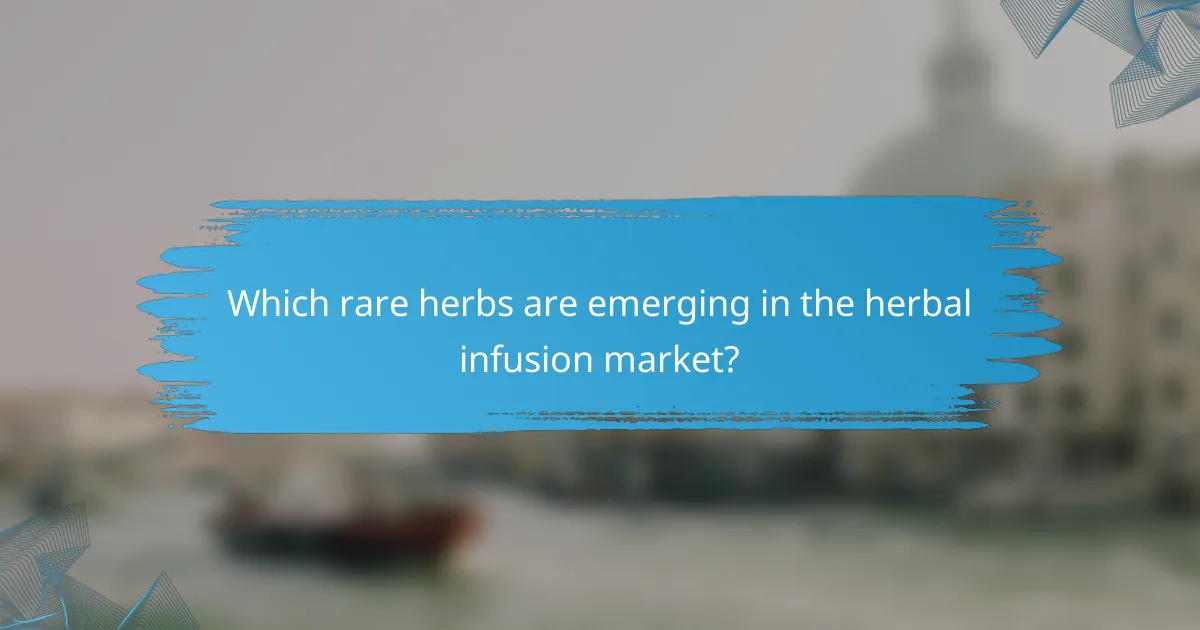Herbal infusions provide numerous health benefits, such as improved digestion and enhanced relaxation. This article explores popular local varieties, including chamomile and hibiscus, while highlighting sustainable harvesting techniques that preserve these valuable resources. Discover the unique attributes of different herbs and learn effective brewing methods for optimal flavour and health benefits.

What are the health benefits of herbal infusions?
Herbal infusions offer various health benefits, including improved digestion, enhanced relaxation, and boosted immunity. These beverages, made from herbs, flowers, and spices, can provide antioxidants and anti-inflammatory properties. For example, chamomile infusions promote sleep, while peppermint can alleviate digestive discomfort. Sustainable harvesting techniques ensure these herbs remain abundant and beneficial for future generations.
How do herbal infusions support digestive health?
Herbal infusions support digestive health by soothing the gastrointestinal tract and promoting digestion. Chamomile, peppermint, and ginger are popular varieties known for their calming effects and ability to reduce bloating. These infusions enhance nutrient absorption and can alleviate symptoms of indigestion. Sustainable harvesting techniques ensure these herbs remain available, preserving their benefits for future generations.
Which herbal infusions are known for their calming effects?
Herbal infusions known for their calming effects include chamomile, lavender, and lemon balm. Chamomile is widely recognised for its ability to reduce anxiety and promote sleep. Lavender is often used for its soothing aroma, which can help alleviate stress. Lemon balm has been shown to improve mood and enhance relaxation. These herbal options are popular choices for individuals seeking natural remedies for stress relief.
What role do antioxidants play in herbal infusions?
Antioxidants in herbal infusions protect cells from oxidative stress and inflammation. They neutralise free radicals, which can cause cellular damage. Common antioxidants in these infusions include flavonoids and polyphenols, contributing to overall health benefits. For instance, green tea is rich in catechins, a type of antioxidant known for enhancing cardiovascular health.

Which local varieties of herbal infusions are popular worldwide?
Popular local varieties of herbal infusions worldwide include chamomile, peppermint, hibiscus, and rooibos. Each offers unique flavours and health benefits. Chamomile is known for its calming effects, while peppermint aids digestion. Hibiscus is rich in antioxidants, and rooibos is caffeine-free. These infusions reflect diverse cultural practices and sustainable harvesting techniques globally.
What are the most sought-after herbal infusions in Europe?
The most sought-after herbal infusions in Europe include chamomile, peppermint, and elderflower. These infusions are prized for their calming effects, digestive benefits, and immune support. Chamomile is known for its unique attribute of promoting relaxation, while peppermint offers a refreshing flavour and aids digestion. Elderflower, often used in syrups, has rare attributes related to its use in traditional remedies for colds. Sustainable harvesting techniques are increasingly important to maintain these valuable resources.
How do local herbal infusion practices differ in Asia?
Local herbal infusion practices in Asia vary significantly due to cultural traditions, available herbs, and preparation methods. For instance, in China, herbal infusions often focus on balancing yin and yang, utilising ingredients like goji berries and ginseng. In India, chai blends incorporate spices such as ginger and cardamom, emphasising both flavour and health benefits. Southeast Asian countries often use local plants like pandan and lemongrass, reflecting regional tastes and health beliefs. These differences highlight unique attributes of each culture’s approach to herbal infusions, promoting sustainability through local harvesting techniques.
Which indigenous herbs are commonly used in North America?
Common indigenous herbs used in North America include echinacea, sage, yarrow, and juniper. These herbs offer various health benefits and are integral to traditional practices.
Echinacea is known for its immune-boosting properties. Sage is often used for digestive health and cleansing rituals. Yarrow has anti-inflammatory effects and is used for wound healing. Juniper serves as a natural antiseptic and is utilised in various herbal infusions.
Sustainable harvesting techniques are essential to preserve these herbs. Gathering herbs responsibly ensures their availability for future generations. Educating communities about these practices supports biodiversity and cultural heritage.

How can sustainable harvesting techniques enhance herbal infusion quality?
Sustainable harvesting techniques enhance herbal infusion quality by preserving plant potency and biodiversity. These methods ensure that herbs are harvested at optimal times, maximising their flavour and therapeutic properties. For instance, selective harvesting encourages healthy growth and maintains ecosystem balance. As a result, the quality of herbal infusions improves, offering richer tastes and greater health benefits. Sustainable practices also promote local varieties, which often possess unique attributes that contribute to distinctive infusion profiles.
What practices ensure the preservation of native plant species?
Sustainable practices for preserving native plant species include habitat conservation, responsible harvesting, and community education. Protecting natural habitats ensures that native plants thrive in their ecosystems. Responsible harvesting techniques, such as selective gathering, prevent over-exploitation. Community education fosters awareness and encourages local stewardship of these valuable resources.
How does ethical sourcing impact herbal infusion production?
Ethical sourcing significantly enhances herbal infusion production by ensuring sustainability and quality. It promotes responsible harvesting practices, protecting ecosystems and local communities. This approach fosters trust and transparency in the supply chain, leading to higher-quality products. Sustainable sourcing also supports biodiversity, allowing for unique local varieties to thrive, which can enhance the flavour and health benefits of herbal infusions.
What are the benefits of wildcrafting versus cultivation?
Wildcrafting offers distinct benefits over cultivation, including enhanced biodiversity and access to unique plant varieties. Wildcrafted herbs often have richer flavours and higher potency due to their natural growing conditions. Additionally, wildcrafting supports sustainable harvesting practices that promote ecosystem health. Cultivated herbs, while more consistent and easier to manage, may lack the diverse phytochemicals found in their wild counterparts. Understanding these differences can inform better choices for herbal infusion enthusiasts seeking quality and sustainability.

What are the unique attributes of specific herbal infusions?
Unique attributes of specific herbal infusions include distinct flavour profiles, therapeutic properties, and local cultural significance. For example, chamomile is known for its calming effects, while hibiscus offers a tart flavour and antioxidant benefits. Additionally, some herbal infusions, like yerba mate, have unique preparation methods that reflect regional traditions. The sustainability of harvesting techniques also varies, with some plants requiring specific conditions for optimal growth.
How do flavour profiles vary among different herbal infusions?
Flavour profiles among herbal infusions vary significantly based on the herbs used, their growing conditions, and preparation methods. For instance, chamomile offers a sweet, apple-like flavour, while peppermint delivers a strong, refreshing taste. Local varieties can introduce unique attributes; for example, wildcrafted herbs may have more complex flavours due to diverse soil and climate conditions. Sustainable harvesting techniques can also impact flavour by preserving the plant’s natural oils and compounds, enhancing the overall infusion experience.
What are the unique preparation methods for traditional herbal infusions?
Unique preparation methods for traditional herbal infusions include cold infusion, decoction, and tincturing. Cold infusion involves steeping herbs in cold water for several hours, preserving delicate flavours and nutrients. Decoction requires boiling tougher plant materials to extract their essence, ideal for roots and bark. Tincturing uses alcohol to extract active compounds, resulting in a concentrated herbal extract. Each method highlights unique attributes, enhancing the overall experience of herbal infusions.

Which rare herbs are emerging in the herbal infusion market?
Emerging rare herbs in the herbal infusion market include adaptogenic herbs like Ashwagandha and less common varieties such as Tulsi and Moringa. These herbs offer unique health benefits and are increasingly sought after for their nutritional properties. Ashwagandha is known for stress relief, while Tulsi has anti-inflammatory effects. Moringa is rich in vitamins and antioxidants, making it a valuable addition to herbal infusions. The growing interest in sustainable harvesting techniques further supports their popularity in the market.
What are the health benefits of lesser-known herbs in infusions?
Lesser-known herbs in infusions offer various health benefits, including improved digestion, enhanced immune function, and reduced stress. Herbs like lemon balm and holy basil contain unique compounds that promote relaxation and mental clarity. Sustainable harvesting techniques ensure these herbs remain available for future generations.
How are rare herbs sourced and integrated into modern herbal infusions?
Rare herbs are sourced through sustainable harvesting techniques that respect local ecosystems. Integrating these herbs into modern herbal infusions involves careful selection and preparation to maintain their unique properties. Local varieties are often prioritised for their cultural significance and adaptability to regional climates. Sustainable practices ensure that these rare herbs are harvested without depleting their populations, allowing for continued use in herbal remedies.

What are the best practices for brewing herbal infusions?
To brew herbal infusions effectively, use fresh or dried herbs, hot water, and steeping time. Start with one tablespoon of herbs per cup of water, and steep for 5 to 15 minutes depending on the herb’s strength. Strain and enjoy.
For optimal flavour, use filtered water and maintain a temperature between 190°F to 212°F. Experiment with local varieties like chamomile or peppermint for unique tastes. Sustainable harvesting techniques, such as foraging responsibly, ensure long-term access to herbal resources.
How can water quality affect the flavour of herbal infusions?
Water quality significantly influences the flavour of herbal infusions. Impurities or high mineral content in water can alter taste profiles, masking the natural flavours of herbs. Using filtered or spring water often enhances the infusion experience by allowing the herbal notes to shine through. Different water sources can impart unique characteristics, affecting the overall enjoyment and health benefits of the infusion.
What is the ideal steeping time for various herbal infusions?
The ideal steeping time for various herbal infusions typically ranges from 5 to 15 minutes. Different herbs require specific durations to extract optimal flavours and benefits.
| Herbal Infusion | Ideal Steeping Time |
|———————–|———————|
| Chamomile | 5 minutes |
| Peppermint | 7 minutes |
| Rooibos | 5-7 minutes |
| Hibiscus | 10-15 minutes |
| Lemon Balm | 5-10 minutes |
| Echinacea | 10 minutes |
Which common mistakes should be avoided when preparing herbal infusions?
To prepare herbal infusions effectively, avoid these common mistakes. First, using water that is too hot can damage delicate herbs, leading to bitterness. Second, not allowing sufficient steeping time can result in weak flavours and diminished health benefits. Third, using low-quality or old herbs compromises the infusion’s potency. Fourth, neglecting to strain the infusion properly can leave undesirable particles in the drink. Lastly, failing to store herbal infusions correctly diminishes their freshness and effectiveness.